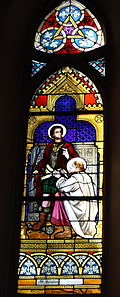
Origen of Alexandria, also known as Origen Adamantius, was an early Christian scholar, ascetic, and theologian who was born and spent the first half of his career in Alexandria. He was a prolific writer who wrote roughly 2,000 treatises in multiple branches of theology, including textual criticism, biblical exegesis and hermeneutics, homiletics, and spirituality. He was one of the most influential and controversial figures in early Christian theology, apologetics, and asceticism. He has been described as "the greatest genius the early church ever produced".
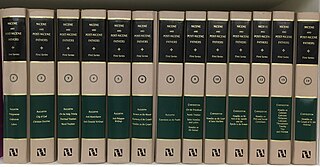
A Select Library of the Nicene and Post-Nicene Fathers of the Christian Church, usually known as the Nicene and Post-Nicene Fathers (NPNF), is a set of books containing translations of early Christian writings into English. It was published between 1886 and 1900.

Hippolytus of Rome was one of the most important second-third century Christian theologians, whose provenance, identity and corpus remain elusive to scholars and historians. Suggested communities include Rome, Palestine, Egypt, Anatolia and other regions of the Middle East. The best historians of literature in the ancient church, including Eusebius of Caesarea and Jerome, openly confess they cannot name where Hippolytus the biblical commentator and theologian served in leadership. They had read his works but did not possess evidence of his community. Photios I of Constantinople describes him in his Bibliotheca as a disciple of Irenaeus, who was said to be a disciple of Polycarp, and from the context of this passage it is supposed that he suggested that Hippolytus so styled himself. This assertion is doubtful. One older theory asserts he came into conflict with the popes of his time and seems to have headed a schismatic group as a rival to the bishop of Rome, thus becoming an antipope. In this view, he opposed the Roman Popes who softened the penitential system to accommodate the large number of new pagan converts. However, he was reconciled to the Church before he died as a martyr.

Didymus the Blind was a Christian theologian in the Church of Alexandria, where he taught for about half a century. He was a student of Origen, and, after the Second Council of Constantinople condemned Origen, Didymus's works were not copied. Many of his writings are lost, but some of his commentaries and essays survive. He was seen as intelligent and a good teacher.
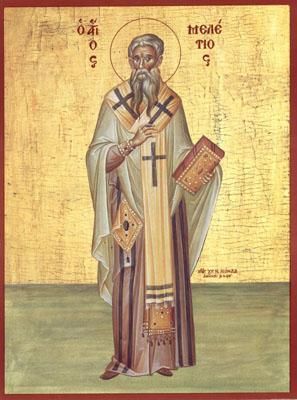
Saint Meletius was a Christian bishop of Antioch from 360 until his death in 381. He was opposed by a rival bishop named Paulinus and his episcopate was dominated by the schism, usually called the Meletian schism. As a result, he was exiled from Antioch in 361–362, 365–366 and 371–378. One of his last acts was to preside over the First Council of Constantinople in 381.

Epiphanius of Salamis was the bishop of Salamis, Cyprus, at the end of the 4th century. He is considered a saint and a Church Father by both the Eastern Orthodox and Catholic Churches. He gained a reputation as a strong defender of orthodoxy. He is best known for composing the Panarion, a compendium of eighty heresies, which included also pagan religions and philosophical systems. There has been much controversy over how many of the quotations attributed to him by the Byzantine Iconoclasts were actually by him. Regardless of this he was clearly strongly against some contemporary uses of images in the church.
Theophilus was the 23rd Pope of Alexandria and Patriarch of the Seat of Saint Mark. He became pope at a time of conflict between the newly dominant Christians and the pagan establishment in Alexandria, each of which was supported by a segment of the Alexandrian populace.
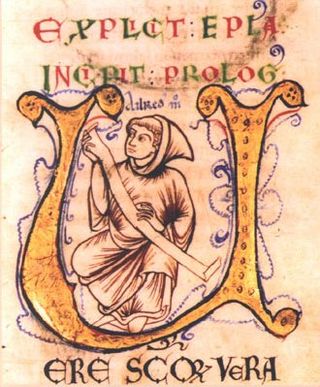
Aelred of Rievaulx, O Cist. ; also Ailred, Ælred, and Æthelred; was an English Cistercian monk, abbot of Rievaulx from 1147 until his death, and known as a writer. He is regarded by Anglicans and Catholics as a saint.
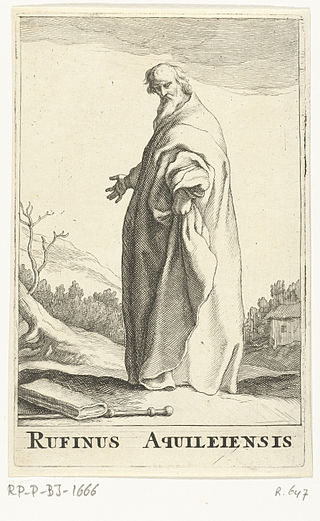
Tyrannius Rufinus, also called Rufinus of Aquileia (344/345–411), was a monk, philosopher, historian, and theologian who worked to translate Greek patristic material, especially the work of Origen, into Latin.
Legend makes Abdias first bishop of Babylon and one of the Seventy Apostles who are collectively mentioned in the Gospel of Luke10:1–20. Saints Simon and Jude allegedly consecrated him as the first Bishop of Babylon. He is also associated with St. Thomas and St. Addai, recognized as the first Patriarch of the Church of the East in Syriac Christianity.
Saint Pamphilus, was a presbyter of Caesarea and chief among the biblical scholars of his generation. He was the friend and teacher of Eusebius of Caesarea, who recorded details of his career in a three-book Vita that has been lost.
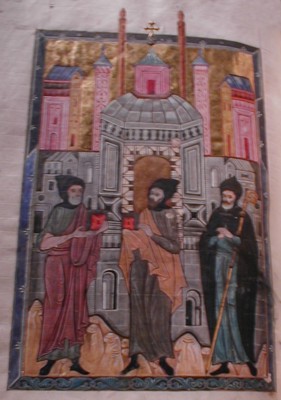
Evagrius Ponticus, also called Evagrius the Solitary, was a Christian monk and ascetic from Heraclea, a city on the coast of Bithynia in Asia Minor. One of the most influential theologians in the late fourth-century church, he was well known as a thinker, polished speaker, and gifted writer. He left a promising ecclesiastical career in Constantinople and traveled to Jerusalem, where in 383 AD he became a monk at the monastery of Rufinus and Melania the Elder. He then went to Egypt and spent the remaining years of his life in Nitria and Kellia, marked by years of asceticism and writing. He was a disciple of several influential contemporary church leaders, including Basil of Caesarea, Gregory of Nazianzus, and Macarius of Egypt. He was a teacher of others, including John Cassian and Palladius of Galatia.

The Patriarchate of Aquileia was an episcopal see and ecclesiastical province in northeastern Italy, originally centered in the ancient city of Aquileia, situated near the northern coast of the Adriatic Sea. It emerged in the 4th century as a metropolitan province, with jurisdiction over the Italian region of Venetia et Histria. In the second half of the 6th century, metropolitan bishops of Aquileia started to use the patriarchal title. Their residence was moved to Grado in 568, after the Lombard conquest of Aquileia. In 606, an internal schism occurred, and since that time there were two rival lines of Aquileian patriarchs: one in New Aquileia (Grado) with jurisdiction over the Byzantine-controlled coastal regions, and the other in Old Aquileia. The first line (Grado) continued until 1451, while the second line continued until 1751. Patriarchs of the second line were also feudal lords of the Patriarchal State of Aquileia. A number of Aquileian church councils were held during the late antiquity and throughout the middle ages. Today, it is an titular archiepiscopal see.
The Aquileian Rite was a particular liturgical tradition of the Patriarchate of Aquileia and hence called the ritus patriarchinus. It was effectively replaced by the Roman Rite by the beginning of the seventeenth century, although elements of it survived in St. Mark's Basilica in Venice until 1807.

Pammachius was a Roman senator who is venerated as a saint in the Eastern Orthodox and Roman Catholic Churches. He married Paulina. After her death, he gave himself up to works of charity.
Gregory Baeticus was the bishop of Elvira, in the province of Baetica, Spain.
Pierius was a Christian priest and probably head of the Catechetical School of Alexandria, conjointly with Achillas. He flourished while Theonas was bishop of Alexandria, and died at Rome after 309. The Roman Martyrology commemorates him on 4 November.
On the First Principles is a theological treatise by the Christian writer Origen. It was the first systematic exposition of Christian theology.

The Origenist crises or Origenist controversies are two major theological controversies in early Christianity involving the teachings of followers of the third-century Alexandrian theologian Origen.
Ancient Christian Writers: the works of the Fathers in translation is a book series with English translations of works by early Christian writers. The translations are made from Latin and Greek. The series was founded by Johannes Quasten and Joseph C. Plumpe, the first volume being published in 1946.
